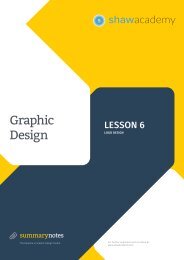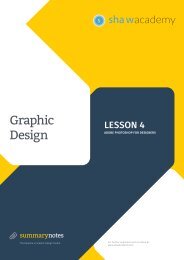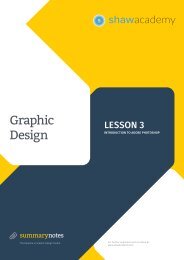You also want an ePaper? Increase the reach of your titles
YUMPU automatically turns print PDFs into web optimized ePapers that Google loves.
S<br />
shawacademy<br />
Graphic<br />
Design<br />
LESSON 2<br />
GRAPHIC DESIGN ELEMENTS & PRINCIPLES<br />
summarynotes<br />
The Diploma in Graphic Design <strong>Toolkit</strong><br />
For further questions visit us online at:<br />
www.shawacademy.com
S <strong>Lesson</strong> 2<br />
S<br />
shawacademy
S <strong>Lesson</strong> 2<br />
DESIGN ELEMENTS &<br />
PRINCIPLES ARE AT<br />
THE CORE OF ANY TYPE<br />
OF DESIGN AND ONCE<br />
YOU ARE FAMILIAR AND<br />
AWARE OF THESE, AND<br />
UNDERSTAND HOW TO<br />
APPLY THEM TO YOUR<br />
OWN WORK, YOU WILL<br />
BECOME A BETTER<br />
DESIGNER.<br />
2.01 Line 6<br />
2.02 Shape 8<br />
2.03 Colour 10<br />
2.04 Texture, Mass & Space 12<br />
2.05 Principles 14
S<br />
Graphic Design Elements & Principles<br />
Elements<br />
&<br />
Principles
S<br />
Graphic Design Elements & Principles<br />
Design elements are what we use to make up our<br />
design. Think of them as ingredients.<br />
Graphic Design is<br />
“the art or<br />
profession of visual<br />
communication that<br />
combines images,<br />
words and ideas to<br />
convey information<br />
to an audience”<br />
Design must<br />
be interpreted<br />
the same way<br />
by everyone<br />
to function.<br />
We have lines and all their variances, short, long,<br />
straight, curvy, dashed, thick or thin.<br />
Shape is a combination of several lines in different<br />
directions creating a new element. Images are also<br />
types of shape. Form describes volume and mass,<br />
or the 3D aspects of an object.<br />
Colour is one of the most important elements even<br />
Black & White.<br />
Texture refers to the characteristics of a surface<br />
that can be tactile as well as visual.<br />
Mass is the physical or visually observable size. It’s<br />
all relative!<br />
Space is important and helps focus on what<br />
matters.<br />
The Principles of design<br />
are what we do to design<br />
elements.<br />
How we apply these<br />
determines how<br />
successful the design is.
S<br />
Elements - Line<br />
“A Line is a form<br />
with width &<br />
length, but no<br />
depth.”
S<br />
Elements - Line<br />
2.01<br />
Line<br />
Line<br />
The direction of a Line can convey mood.<br />
Horizontal – calmness, stability, tranquility<br />
Vertical – balance, formality, alertness<br />
Oblique/Diagonal – movement, action<br />
Curved – fluidity, differing variances generate different moods<br />
Zig-Zag – excitement, intense, danger<br />
Thin – fragile, elegant<br />
Thick – strength, emphasis<br />
Lines can be literal or implied.<br />
Line Types<br />
Contour lines are used to define edges. The create boundaries around or<br />
inside an object. Most lines you encounter are contour lines. In design these<br />
could be the borders you add around an object or group of objects.<br />
Dividing lines can also define edges, but what distinguishes them from<br />
contour lines is they divide space. The lines between columns of text are<br />
dividing lines.<br />
Decoration lines are used to embellish an object. Cross-hatching is an<br />
example of using decoration lines to add shading and form to an object.<br />
Gesture lines are quick and rough continuous lines used to capture form and<br />
movement. They are generally used when studying the shape and motion of<br />
the form. You likely won’t use gesture lines, but you could certainly create<br />
patterns of lines to signify motion of a form.<br />
Line Patterns<br />
A series of lines form a pattern.<br />
Patterns convey meaning in addition to the meaning of individual lines.<br />
Parallel lines of uniform width and spacing create a static and orderly effect.<br />
By varying the spacing between lines of equal thickness we can convey<br />
motion. When the spacing between lines of the same thickness is random<br />
we get a dynamic effect with little order. When we vary both spacing and<br />
thickness the effect becomes more chaotic and disorderly.<br />
Lines can be made up of type or any shape placed one after the other.
S<br />
Elements - Shape<br />
“Shapes have<br />
meaning and are<br />
an important<br />
building block<br />
in the visual<br />
grammar and<br />
visual thinking<br />
we have at our<br />
disposal as<br />
designers.”
S<br />
Elements - Shape<br />
2.02<br />
Shape<br />
Shape Types<br />
Geometric shapes are what<br />
most people think of as<br />
shapes. Circles, squares,<br />
triangles, diamonds are<br />
made up of regular patterns<br />
that are easily recognizable.<br />
This regularity suggests organisation<br />
and efficiency.<br />
It suggests structure.<br />
Geometric shapes tend<br />
to be symmetrical further<br />
suggesting order.<br />
Natural/Organic shapes are<br />
irregular. They have more<br />
curves and are uneven. They<br />
tend to be pleasing and<br />
comforting. While they can<br />
be man-made (ink blobs),<br />
they are more typically<br />
representative of shapes<br />
found in nature such as a<br />
leaves, rocks, and clouds. In<br />
design organic shapes are<br />
generally created through<br />
the use of illustration and<br />
photography. They are<br />
free form and asymmetrical<br />
and convey feelings of<br />
spontaneity. Organic shapes<br />
add interest and reinforce<br />
themes.<br />
Abstract shapes have a recognisable<br />
form, but are<br />
not real. They are stylized<br />
or simplified versions. A<br />
stick figure is an abstract<br />
shape depicting a person.<br />
Typographic glyphs are<br />
abstract shapes to represent<br />
letters. Icons are abstract<br />
shapes to represent ideas<br />
and concepts. Some<br />
abstract shapes have near<br />
universal recognition.<br />
Shape Meanings<br />
Circles have no beginning or end. They suggested well-roundedness and<br />
completeness. Circles have free movement. Shading and lines can enhance<br />
this sense of movement in circles. Circles are graceful and their curves are<br />
seen as feminine. Their movement suggests energy and power. Their completeness<br />
suggests the infinite, unity, and harmony.<br />
Circles protect, they endure, they restrict. They confine what’s within<br />
and keep things out. They offer safety and connection. Circles suggests<br />
community, integrity, and perfection.<br />
Because they are less common in design they work well to attract attention,<br />
provide emphasis, and set things apart.<br />
Squares and rectangles are stable. They’re familiar and trusted shapes and<br />
suggest honesty. They have right angles and represent order, mathematics,<br />
rationality, and formality. Rectangles are the most common geometric shape<br />
encountered. The majority of text we read is set in rectangles or squares.<br />
Squares and rectangles suggest conformity, peacefulness, solidity, security,<br />
and equality. Their familiarity and stability, along with their commonness can<br />
seem boring. They are generally not attention getters, but can be tilted to<br />
add an unexpected twist. Think of designs that tilt images to help them stand<br />
out.<br />
Triangles can be stable when sitting on their base or unstable when not.<br />
They represent dynamic tension, action, and aggression. Triangles have<br />
energy and power and their stable/unstable dynamic can suggest either<br />
conflict or steady strength. They are balanced and can be a symbol for law,<br />
science, and religion.<br />
The strength of triangles suggests masculinity.<br />
Triangles can be used to convey progression, direction, and purpose.<br />
Spirals are expressions of creativity. They are often found in the natural<br />
growth pattern of many organisms and suggest the process of growth and<br />
evolution. Spirals convey ideas of fertility, birth, death, expansion, and transformation.<br />
They are cycles of time, life, and the seasons and are a common<br />
shape in religious and mystical symbolism.<br />
Crosses symbolize spirituality and healing. They are seen as the meeting<br />
place of divine energies. Crosses suggest transition, balance, faith, unity,<br />
temperance, hope, and life.
S<br />
Elements - Colour<br />
“Colour is one of<br />
the most powerful<br />
tools that a<br />
designer can draw<br />
upon and understanding<br />
how<br />
colour affects us<br />
is key in communicating<br />
messages<br />
effectively.”
S<br />
Elements - Colour<br />
2.03<br />
Colour<br />
RELATIVE<br />
Colour is relative. What<br />
you see and I see may be<br />
different versions of the<br />
same colour.<br />
ABSENCE<br />
Good design should work in<br />
the absence of colour.<br />
ENHANCE<br />
Colour should be used to<br />
enhance design, shouldn’t<br />
be the design.<br />
Reflective Colour<br />
Physical objects, when<br />
struck by light (the visible<br />
kind), will reflect back<br />
certain wavelengths of light<br />
to your eyes.<br />
However, colour in this<br />
regard depends on one<br />
important idea: wavelengths<br />
of light are subtracted as<br />
they are reflected off of an<br />
object.<br />
Additive Colour (RGB)<br />
Monitors display colour in a<br />
much different way.<br />
Because they generate<br />
their own light, they must<br />
generate their own colour as<br />
well.<br />
Generally, the three<br />
“primaries” used to create<br />
colours are red, green, and<br />
blue.<br />
If a computer monitor<br />
displays purple, it actually<br />
lights up both blue and red<br />
pixels in a given area.<br />
Colour Theory<br />
CONTRASTING/COMPLIMENTARY COLORS<br />
Complementary colours are any two colours which are directly opposite each<br />
other, such as red and green, blue and orange.<br />
ANALOGOUS COLOURS<br />
Analogous colours are any colours that sit next to each other on the colour<br />
wheel, such as green, yellow, orange. Typically, designers will choose colours<br />
like this in groups of three; this practice is known as selecting triads.<br />
RECTANGULAR COLOUR<br />
Rectangular colour schemes are not only the most complex, but the hardest<br />
to work with. Picking the colours for these is fairly straightforward, you simply<br />
draw a rectangle over the colour wheel; each of the corners anchored to a<br />
particular colour.<br />
EMOTIONS AND FEELINGS ASSOCIATED WITH COLOURS<br />
Each colour has a lightness and emotion associated with it.<br />
Warm Colours<br />
Warm colours “pull forward” more than cool colours. In this way, a dark<br />
version of a warm colour will appear to be the same brightness as a mathematically<br />
lighter version of a cool colour.<br />
Red:<br />
Orange:<br />
Yellow:<br />
Cool Colours<br />
Energy, Power, Passion, Love<br />
Happiness, Enthusiasm, Attraction, Success<br />
Cheerfulness, Stimulation, Attention-seeking<br />
Cool colours “push backward” or recede more than warm colours. In this way,<br />
a light version of a cool colour will appear to be the same brightness as a<br />
mathematically darker version of a warm colour.<br />
Green:<br />
Blue:<br />
Purple:<br />
Refreshing, fresh, prestige, cooling, calming,<br />
Reliable, trustworthy, dependable, restful<br />
Spirituality, ceremony, mystery, transformation, royalty
S<br />
Elements - Texture, Mass, Space<br />
“Rules were made<br />
to be broken, of<br />
course, but you<br />
have to know<br />
what they are<br />
first.”
S<br />
Elements - Texture, Mass, Space<br />
2.04<br />
Texture, Mass & Space<br />
Mass<br />
Mass equals size. Size can<br />
be relative. Each piece you<br />
create has a physical mass.<br />
The physical mass or size<br />
is the actual dimensions of<br />
the piece — height, width,<br />
thickness/weight (of paper),<br />
and depth (3D objects).<br />
There is a Physical Size and<br />
a Visual Size<br />
A Physically small brochure<br />
can have a great deal of<br />
mass through the use of<br />
heavy text and graphic<br />
elements<br />
A Physically large brochure<br />
can appear smaller, lighter<br />
by using text and graphics<br />
sparingly<br />
Texture<br />
Texture refers to the characteristics of a surface that can be tactile as well as<br />
visual. It’s not only for print.<br />
Texture can add an emotional and ‘real-life’ response.<br />
Depending on what artistic venue you’re working in, texture should be used<br />
differently. For example, logo design should keep texture to a minimum, while<br />
web or graphic design can use a lot more.<br />
Texture can be related to the context in which it is inserted – complimenting<br />
or strengthening.<br />
Textures can create a more three-dimensional appearance on a two-dimensional<br />
surface. It also helps build an immersive world.<br />
Texture acts as a secondary element giving support to the main image,<br />
reinforcing the visual concept.<br />
Space<br />
Space is actually ‘negative space’ – in other words, the gaps and space<br />
between graphic elements on a page, so this could actually be any colour.<br />
The more graphic elements that are displayed and the closer they are to one<br />
another, then the more difficult it is for the viewer to make sense of page (or<br />
design). E.G. It takes a lot less time to read a bold headline than an entire<br />
paragraph.<br />
Legibility Making something clear and easy to read is important.<br />
Headlines/Titles - leaving sufficient space around important messages (such<br />
as headlines) ensures that they will stand out – it’s a way of providing a<br />
visual clue for the reader to know ‘where to start’. Body Text - equally, having<br />
enough space between lines of text and between paragraphs keeps the text<br />
looking light and approachable – after all, who isn’t put off when faced with<br />
paragraphs of tightly spaced text.<br />
Aesthetic Generally speaking, most people like things that look<br />
beautiful, elegant, uncluttered, even pretty. (White) space does this. It allows<br />
a design to breathe. Like a frame around a picture, it helps to give definition<br />
to the graphic elements that are displayed. As with type, if you cram lots of<br />
images together they can become difficult to distinguish, and the inherent<br />
impact of each can become lessened.<br />
There will always be an exception.<br />
This is as considered as a principle and convention, not a rule.
S<br />
Graphic Design Principles<br />
The Principles of<br />
design are what<br />
we do to design<br />
elements.<br />
How we apply<br />
these determines<br />
how successful<br />
the design is.
S<br />
Graphic Design Principles<br />
2.05<br />
Graphic Design<br />
Principles<br />
ALIGNMENT Alignment allows us to create order and organisation.<br />
Aligning elements allows them to create a visual connection with each other.<br />
The two basic alignment principles are Edge Alignment and Centre Alignment.<br />
BALANCE Balance is the weight distributed in the design by the<br />
placement of your elements. Provides stability and structure to a design. E.G.<br />
A large shape close to the centre can be balanced by a small shape close to<br />
the edge.<br />
Symmetrical balance occurs when the visual weight is evenly divided in<br />
terms of horizontal, vertical or radial. This style relies on a balance of two<br />
similar elements from two different sides.<br />
Asymmetrical balance occurs when the visual weight of design elements are<br />
not evenly distributed in the central axis. This style relies on visual games,<br />
such as scale, contrast and colour to achieve a balance.<br />
CONTRAST Contrast is the juxtaposition of opposing elements (opposite<br />
colours on the colour wheel, or value light/dark, or direction horizontal/<br />
vertical).<br />
Contrast allows us to emphasise or highlight key elements in your design.<br />
Without Contrast a design can seem uninteresting and not be clear what to<br />
look at first.<br />
Types of contrast include Size, Value, Quantity, Weight, Placement & Texture<br />
PROXIMITY Proximity is simply the process of ensuring related design<br />
elements are grouped together. Any unrelated items, should be spaced apart.<br />
Close proximity indicates that items are connected or have a relationship<br />
to each other and become one visual unit which helps to organise or give<br />
structure to a layout.<br />
Proximity doesn’t mean that elements have to be placed together, it means<br />
they should be visually connected in some way.<br />
REPETITION Repetition strengthens a design by tying together individual<br />
elements. It helps create association and consistency. Repetition can create<br />
rhythm (a feeling of organised movement).
S







